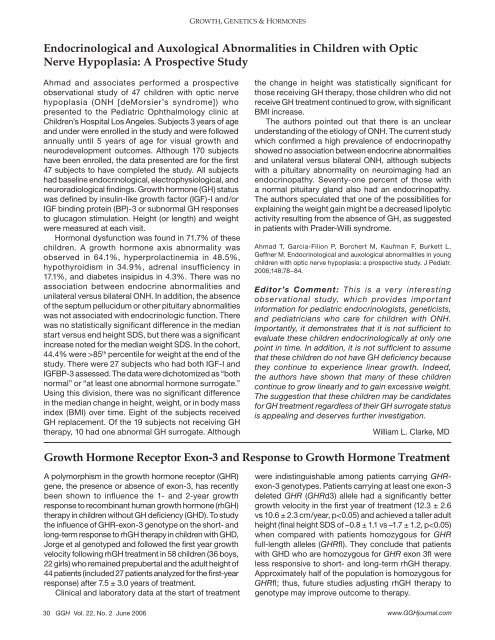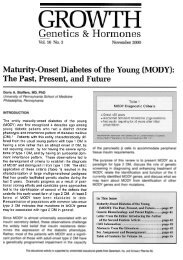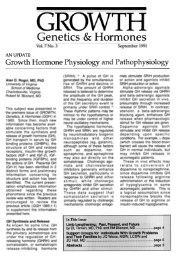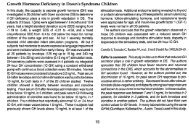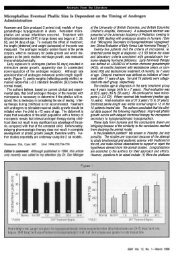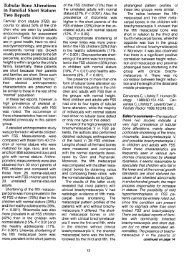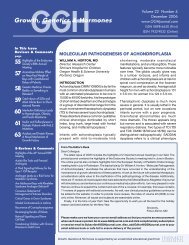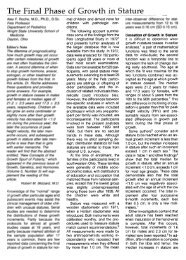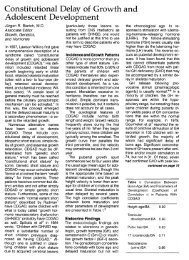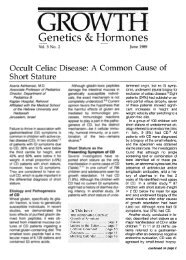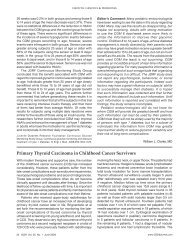Download pdf of current issue - GGH Journal
Download pdf of current issue - GGH Journal
Download pdf of current issue - GGH Journal
Create successful ePaper yourself
Turn your PDF publications into a flip-book with our unique Google optimized e-Paper software.
GROWTH, GENETICS & HORMONES<br />
Endocrinological and Auxological Abnormalities in Children with Optic<br />
Nerve Hypoplasia: A Prospective Study<br />
Ahmad and associates performed a prospective<br />
observational study <strong>of</strong> 47 children with optic nerve<br />
hypoplasia (ONH [deMorsier’s syndrome]) who<br />
presented to the Pediatric Ophthalmology clinic at<br />
Children’s Hospital Los Angeles. Subjects 3 years <strong>of</strong> age<br />
and under were enrolled in the study and were followed<br />
annually until 5 years <strong>of</strong> age for visual growth and<br />
neurodevelopment outcomes. Although 170 subjects<br />
have been enrolled, the data presented are for the first<br />
47 subjects to have completed the study. All subjects<br />
had baseline endocrinological, electrophysiological, and<br />
neuroradiological findings. Growth hormone (GH) status<br />
was defined by insulin-like growth factor (IGF)-I and/or<br />
IGF binding protein (BP)-3 or subnormal GH responses<br />
to glucagon stimulation. Height (or length) and weight<br />
were measured at each visit.<br />
Hormonal dysfunction was found in 71.7% <strong>of</strong> these<br />
children. A growth hormone axis abnormality was<br />
observed in 64.1%, hyperprolactinemia in 48.5%,<br />
hypothyroidism in 34.9%, adrenal insufficiency in<br />
17.1%, and diabetes insipidus in 4.3%. There was no<br />
association between endocrine abnormalities and<br />
unilateral versus bilateral ONH. In addition, the absence<br />
<strong>of</strong> the septum pellucidum or other pituitary abnormalities<br />
was not associated with endocrinologic function. There<br />
was no statistically significant difference in the median<br />
start versus end height SDS, but there was a significant<br />
increase noted for the median weight SDS. In the cohort,<br />
44.4% were >85 th percentile for weight at the end <strong>of</strong> the<br />
study. There were 27 subjects who had both IGF-I and<br />
IGFBP-3 assessed. The data were dichotomized as “both<br />
normal” or “at least one abnormal hormone surrogate.”<br />
Using this division, there was no significant difference<br />
in the median change in height, weight, or in body mass<br />
index (BMI) over time. Eight <strong>of</strong> the subjects received<br />
GH replacement. Of the 19 subjects not receiving GH<br />
therapy, 10 had one abnormal GH surrogate. Although<br />
the change in height was statistically significant for<br />
those receiving GH therapy, those children who did not<br />
receive GH treatment continued to grow, with significant<br />
BMI increase.<br />
The authors pointed out that there is an unclear<br />
understanding <strong>of</strong> the etiology <strong>of</strong> ONH. The <strong>current</strong> study<br />
which confirmed a high prevalence <strong>of</strong> endocrinopathy<br />
showed no association between endocrine abnormalities<br />
and unilateral versus bilateral ONH, although subjects<br />
with a pituitary abnormality on neuroimaging had an<br />
endocrinopathy. Seventy-one percent <strong>of</strong> those with<br />
a normal pituitary gland also had an endocrinopathy.<br />
The authors speculated that one <strong>of</strong> the possibilities for<br />
explaining the weight gain might be a decreased lipolytic<br />
activity resulting from the absence <strong>of</strong> GH, as suggested<br />
in patients with Prader-Willi syndrome.<br />
Ahmad T, Garcia-Filion P, Borchert M, Kaufman F, Burkett L,<br />
Geffner M. Endocrinological and auxological abnormalities in young<br />
children with optic nerve hypoplasia: a prospective study. J Pediatr.<br />
2006;148:78−84.<br />
Editor’s Comment: This is a very interesting<br />
observational study, which provides important<br />
information for pediatric endocrinologists, geneticists,<br />
and pediatricians who care for children with ONH.<br />
Importantly, it demonstrates that it is not sufficient to<br />
evaluate these children endocrinologically at only one<br />
point in time. In addition, it is not sufficient to assume<br />
that these children do not have GH deficiency because<br />
they continue to experience linear growth. Indeed,<br />
the authors have shown that many <strong>of</strong> these children<br />
continue to grow linearly and to gain excessive weight.<br />
The suggestion that these children may be candidates<br />
for GH treatment regardless <strong>of</strong> their GH surrogate status<br />
is appealing and deserves further investigation.<br />
William L. Clarke, MD<br />
Growth Hormone Receptor Exon-3 and Response to Growth Hormone Treatment<br />
A polymorphism in the growth hormone receptor (GHR)<br />
gene, the presence or absence <strong>of</strong> exon-3, has recently<br />
been shown to influence the 1- and 2-year growth<br />
response to recombinant human growth hormone (rhGH)<br />
therapy in children without GH deficiency (GHD). To study<br />
the influence <strong>of</strong> GHR-exon-3 genotype on the short- and<br />
long-term response to rhGH therapy in children with GHD,<br />
Jorge et al genotyped and followed the first year growth<br />
velocity following rhGH treatment in 58 children (36 boys,<br />
22 girls) who remained prepubertal and the adult height <strong>of</strong><br />
44 patients (included 27 patients analyzed for the first-year<br />
response) after 7.5 ± 3.0 years <strong>of</strong> treatment.<br />
Clinical and laboratory data at the start <strong>of</strong> treatment<br />
were indistinguishable among patients carrying GHRexon-3<br />
genotypes. Patients carrying at least one exon-3<br />
deleted GHR (GHRd3) allele had a significantly better<br />
growth velocity in the first year <strong>of</strong> treatment (12.3 ± 2.6<br />
vs 10.6 ± 2.3 cm/year, p


